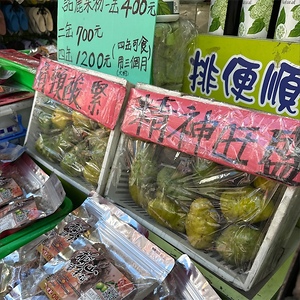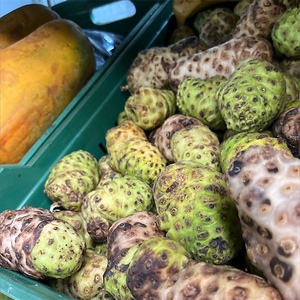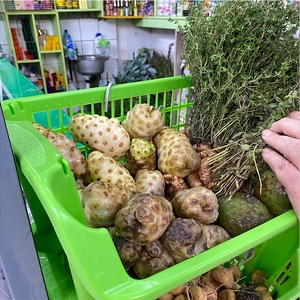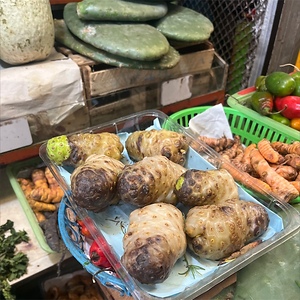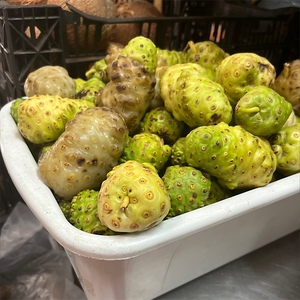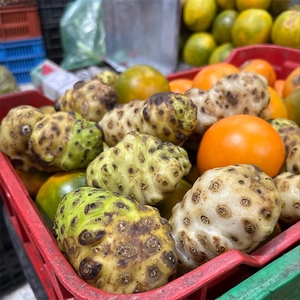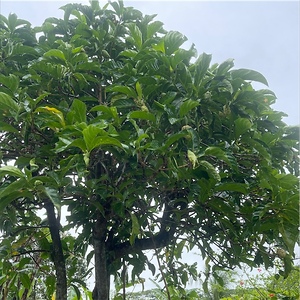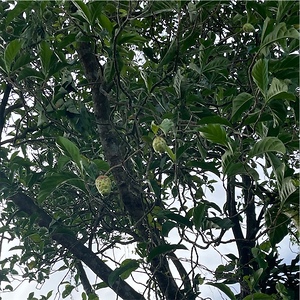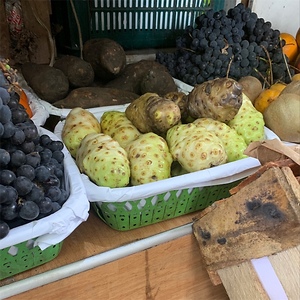

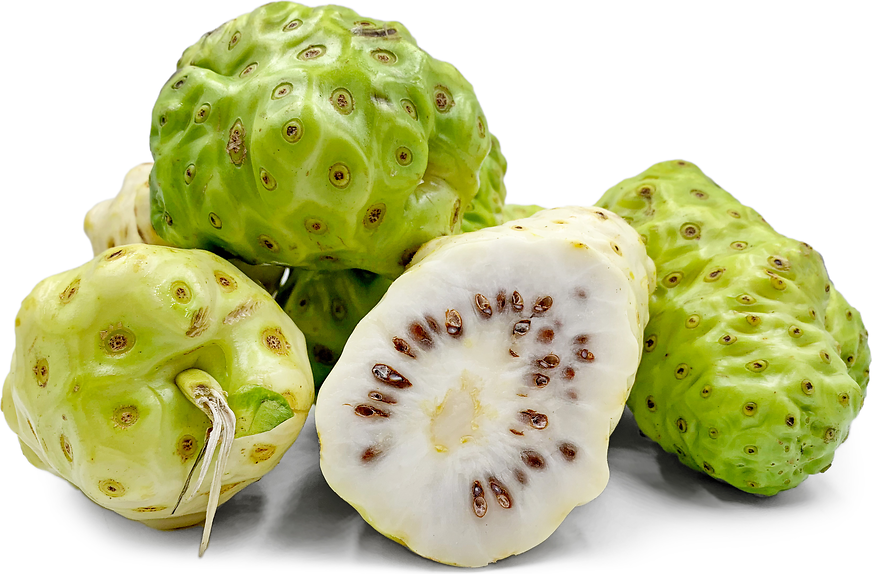
Noni Fruit
Estimated Inventory, lb : 0
Description/Taste
Noni fruits are generally small to medium in size, averaging 5 to 10 centimeters in length and 3 to 4 centimeters in diameter, and have an irregular, oval to oblong shape. The fruits have a lumpy, slightly bumpy appearance and bear many small, angular, flat faces with light brown dots on each face. One of the unusual characteristics of Noni trees is they produce fruits before they flower. The small white flowers emerge from the brown dots on the hard, unripe fruit, and each fruit can bear 50 to 75 flowers. Once the flowers fall off, the fruits will begin to ripen, transforming in color and aroma. Unripe Noni fruits have thin, firm skin with a light to dark green hue, and the flesh is very firm, fibrous, and tough. As the fruits ripen, the skin will turn a translucent yellow-white, and the flesh will soften into a succulent, aqueous consistency similar to a tomato. The flesh also encases many red-brown oval seeds. Noni fruits develop a pungent, offensive odor when mature, often likened to a blend of smelly cheese, horseradish, fish, and rotting fruit. The flesh and juice also contain this strong smell and have a somewhat distinct, bitter, sharp, and acidic flavor.
Seasons/Availability
Noni fruits are available year-round.
Current Facts
Noni, botanically classified as Morinda citrifolia, is a tropical fruit that grows on evergreen trees reaching 3 to 9 meters in height, belonging to the Rubiaceae family. The oddly shaped fruits have been growing wild since ancient times, and Noni trees have been historically considered a life-giving tree as the fruit, leaves, and bark are used for medicinal, cultural, and ceremonial purposes. Noni fruits have been naturalized in tropical regions worldwide, and there are over 100 regional names for the fruits, including Indian Mulberry, Canary Wood, Luo Ling, Nonu, Nano, Hai Ba Ji, Lada, Nen, Ura, Mora de la India, Munja Pavattay, and Nono fruits. Noni fruits have also developed an unsavory reputation for their odoriferous nature despite their beneficial medicinal properties. Ripe Noni fruits emit a strong, disagreeable aroma, leading the fruits to be nicknamed Cheese and Vomit fruits. The scent lingers in the air, remains on clothing, and can stick on the hands, leaving an unforgettable sensory experience. In the modern-day, scientists have begun studying Noni fruits as a nutritional supplement, and several countries worldwide are cultivating the fruits for use in juices, powders, cosmetics, and soaps.
Nutritional Value
Noni fruits are a source of potassium to balance fluid levels within the body, vitamin C to strengthen the immune system, antioxidants to reduce inflammation, and contains other nutrients, including vitamin E, biotin, phosphorus, iron, and magnesium. In natural medicines, Noni fruits have been used to treat many ailments from ulcers, digestive issues, diabetes, to arthritis. The fruits are most prevalent in Hawaiian medicines, known as la’au lapa’au. Green Noni fruits were often smashed with sea salt and applied topically on skin wounds to relieve pain and inflammation in Polynesia. White, ripe fruits were also mashed with water and gargled to soothe sore throats, spread over skin irritations, or used on sores around or in the mouth. Some consumers drink Noni fruit juice or take supplements as an immune-boosting, anti-aging supplement in modern medicines.
Applications
Noni fruits can be consumed in their semi-unripe green state or mature white stage and offer a sharp, bitter, and acidic flavoring. The fruits are generally used in their ripe stage as the juice has mellowed slightly, but the fruits are not typically consumed out of hand. Raw Noni fruits are mostly considered a famine food that is only eaten fresh in times of hardship. The preferred method is to combine the juice with other stronger flavored juices to create a tropical drink. Noni fruits are also mixed with citrus to help mask the odor, or they are blended into shakes with other fruits as a creamier, thicker beverage. In addition to drinks, green Noni fruits can be sliced thinly and incorporated into stir-fries, simmered into curries, or blended into salad dressings and spiced vinegar. For commercial uses, the fruits are freeze-dried or air-dried and integrated into a powder sold loose or in capsule form. This powder can be mixed into smoothies and teas. Noni fruits can also be pureed and dried into fruit leather as a chewy snack or dried and rehydrated into a sun tea. Noni fruits pair well with fruits such as passion fruits, mangos, pineapples, blackberries, raspberries, grapes, bananas, citrus, and cherries, spices including allspice, cloves, and cinnamon, and savory ingredients such as red curry paste, cauliflower, peas, and zucchini. Noni fruits are not commonly stored whole in the house due to their pungent odor, but the juice can be refrigerated for 2 to 3 weeks.
Ethnic/Cultural Info
Noni fruits were one of twenty-four plants carried with the Polynesians on their oceanic journey across the Pacific Ocean to Hawaii. Noni was chosen as one of the vital plants as the bark of the tree could be used as a natural dye for fabrics and paper, the leaves, bark, and fruits were used in natural medicines, and the fruits were considered a famine food, providing nutrition in times of need. When the Polynesians arrived in Hawaii, Noni fruit trees were planted throughout the islands and became deeply intertwined into the spiritual, medicinal, and cultural practices of the settlers. Polynesians believed Noni fruits were a gift from the gods. The fruits are specifically connected to the volcano goddess Pele, as the fruits are one of the only trees capable of growing in areas that have been destroyed by lava flows. Some Polynesian legends also compare the sourness of the Noni juice to the sour and fiery nature of the goddess.
Geography/History
Noni fruit is native to the tropical islands surrounding New Guinea and has been growing wild since ancient times. The trees thrive in a wide range of soils and climatic conditions and can be found growing along coastlines, on cliffsides, in forests, near old lava flows, and in fields. Noni trees were first spread to neighboring islands through seeds being carried with ocean currents. Over time, indigenous populations around New Guinea began to migrate to other islands such as Tonga, Fiji, and Samoa, bringing Noni seeds to plant as medicinal trees. Polynesians are credited with spreading Noni trees worldwide. The seeds were carried in the Polynesian canoes as they ventured to Tahiti, Hawaii, and other tropical islands. The seeds were planted and left to grow, naturalizing Noni trees in many different regions. Noni fruits were introduced to European scientists through Carl Linnaeus and a team of Swedish researchers that collected exotic plants from the New World in the 1760s. In the late 1700s, more explorers and researchers also began documenting the fruits, including Captain James Cook, the British explorer who was the first European to reach the Hawaiian Islands. After their initial discovery, Noni fruits remained mostly unknown outside of the tribes and peoples who have used the fruits, trees, and leaves in their culture for generations, but the fruits continued to naturalize in regions worldwide, including Central America and the Caribbean. There were also ancient Ayurveda texts from India that mentioned the fruits being used medicinally, indicating that the trees had been introduced into Southeast Asia. Noni fruits did not become popular worldwide until the 1980s. During this time, they were being explored for their nutritional properties, leading the fruits to become a niche health food ingredient in the early 2000s. Today Noni fruit is grown in tropical climates worldwide and is commercially produced, planted in home gardens, and harvested from wild trees. The fruits are not commonly seen fresh in grocers due to their offensive odor, but they can be found through local markets. Most commercially grown Noni fruits are processed into juices, supplements, and powders.
Recipe Ideas
Recipes that include Noni Fruit. One
| YouTube |
|
Fresh Noni Juice |
| Live Strong |
|
Noni Fruit |



